Laser Butt Welding of Thin Ti6Al4V Sheets: Effects of Welding Parameters
Abstract
:1. Introduction
2. Materials and Methods
3. Results
3.1. Microstructure
3.2. Microhardness
3.3. Tensile Properties
3.4. Fracture Surface Analysis
4. Conclusions
- The microstructure of the BM contains α and β phases. The FZ has a needle-like lamella structure and a martensitic microstructure due to the heat input exceeding the transus temperature.
- The microhardness is highest at the FZ and decreases as it gets closer to the BM. The martensitic microstructure within the HAZ and FZ is responsible for the increased hardness.
- There is a reduction in ductility for all samples because of the α martensitic microstructure within the WZ.
- Based on the tensile strength, the sample welded using laser power of 2.6 kW and welding speed of 2.6 m/min exhibited the maximum tensile strength.
- Porosity was observed as the primary defect that affected the weld’s quality and reduced mechanical strength.
Supplementary Materials
Author Contributions
Funding
Institutional Review Board Statement
Informed Consent Statement
Data Availability Statement
Acknowledgments
Conflicts of Interest
References
- Omoniyi, P.O.; Akinlabi, E.T.; Mahamood, R.M. Heat treatments of Ti6Al4V alloys for industrial applications: An overview. In Proceedings of the 4th International conference on Engineering for a Sustainable World, Ota, Ogun, Nigeria, 10–14 August 2020. [Google Scholar]
- Omoniyi, P.O.; Akinlabi, E.T.; Mahamood, R.M. Microstructural and mechanical properties of laser deposited Ti-6Al-4V alloy: A review. In Proceedings of the 4th International conference on Engineering for a Sustainable World, Ota, Ogun, Nigeria, 10–14 August 2020. [Google Scholar] [CrossRef]
- Omoniyi, P.O.; Mahamood, R.M.; Akinlabi, E.T. Impact of process parameters of laser welding on the mechanical properties of Ti6Al4V: A review. J. Chem. Technol. Metall. 2021, 56, 1074–1081. [Google Scholar]
- Hernando, I.; Arrizubieta, J.I.; Lamikiz, A.; Ukar, E. Laser beam welding analytical model when using wobble strategy. Int. J. Heat Mass Transf. 2020, 149, 119248. [Google Scholar] [CrossRef]
- Liu, J.; Gao, X.L.; Zhang, L.J.; Zhang, J.X. A study of fatigue damage evolution on pulsed Nd: YAG Ti6Al4V laser welded joints. Eng. Fract. Mech. 2014, 117, 84–93. [Google Scholar] [CrossRef]
- Cao, X.; Jahazi, M. Effect of welding speed on butt joint quality of Ti-6Al-4V alloy welded using a high-power Nd:YAG laser. Opt. Lasers Eng. 2009, 47, 1231–1241. [Google Scholar] [CrossRef]
- Kashaev, N.; Ventzke, V.; Fomichev, V.; Fomin, F.; Riekehr, S. Effect of Nd:YAG laser beam welding on weld morphology and mechanical properties of Ti-6Al-4V butt joints and T-joints. Opt. Lasers Eng. 2016, 86, 172–180. [Google Scholar] [CrossRef]
- Squillace, A.; Prisco, U.; Ciliberto, S.; Astarita, A. Effect of welding parameters on morphology and mechanical properties of Ti-6Al-4V laser beam welded butt joints. J. Mater. Process. Technol. 2012, 212, 427–436. [Google Scholar] [CrossRef]
- Hong, K.M.; Shin, Y.C. Analysis of microstructure and mechanical properties change in laser welding of Ti6Al4V with a multiphysics prediction model. J. Mater. Process. Technol. 2016, 237, 420–429. [Google Scholar] [CrossRef]
- ASTM B265. Standard specification for titanium and titanium alloy strip, sheet, and plate. ASTM Stand. 2010, 3, 1–9. [Google Scholar] [CrossRef]
- ASTM Standard. Standard Practice for Microetching Metals and Alloys ASTM E-407. ASTM Stand. 2016, 7, 1–22. [Google Scholar] [CrossRef]
- ASTM E384. ASTM E384-2016: Standard test method for knoop and vickers hardness of materials. ASTM Stand. 2016, 16, 1–43. [Google Scholar] [CrossRef]
- ASTM E8. Standard test methods for tension testing of metallic materials. ASTM Stand. 2016, 16, 1–30. [Google Scholar] [CrossRef]
- Adekunle, A.S.; Adeleke, A.A.; Ikubanni, P.P.; Omoniyi, P.O.; Gbadamosi, T.A.; Odusote, J.K. Mechanical properties and microstructural evaluation of heat-treated aluminum alloy using formulated bio-quenchants. Int. Rev. Appl. Sci. Eng. 2020, 11, 243–250. [Google Scholar] [CrossRef]
- Adekunle, A.S.; Adeleke, A.A.; Ikubanni, P.P.; Omoniyi, P.O.; Gbadamosi, T.A.; Odusote, J.K. Effect of copper addition and solution heat treatment on the mechanical properties of aluminum alloy using formulated bio-quenchant oils. Eng. Appl. Sci. Res. 2020, 47, 297–305. [Google Scholar] [CrossRef]
- Omoniyi, P.; Adekunle, A.; Ibitoye, S.; Olorunpomi, O.; Abolusoro, O. Mechanical and microstructural evaluation of aluminium matrix composite reinforced with wood particles. J. King Saud Univ. Eng. Sci. 2021, 1–6, in press. [Google Scholar] [CrossRef]
- Omoniyi, P.O.; Mahamood, R.M.; Arthur, N.; Pityana, S.; Akinlabi, S.A.; Hassan, S.; Okamoto, Y.; Maina, M.R.; Akinlabi, E.T. Investigation of the mechanical and microstructural properties of TIG Welded Ti6Al4V alloy. In Advances in Material Science and Engineering: Selected Articles from ICMMPE 2020; Springer Nature Singapore Pte Ltd.: Singapore, 2021; pp. 111–118. [Google Scholar]
- Gao, X.L.; Zhang, L.J.; Liu, J.; Zhang, J.X. A comparative study of pulsed Nd: YAG laser welding and TIG welding of thin Ti6Al4V titanium alloy plate. Mater. Sci. Eng. A 2013, 559, 14–21. [Google Scholar] [CrossRef]
- Casalino, G.; Mortello, M.; Campanelli, S.L. Ytterbium fiber laser welding of Ti6Al4V alloy. J. Manuf. Process. 2015, 20, 250–256. [Google Scholar] [CrossRef]
- Kovačócy, P.; Šimeková, B.; Kovaříková, I.; Hodúlová, E.; Dománková, M.; Ptačinová, J.; Jurči, P. Investigation of the microstructure and mechanical characteristics of disk laser-welded Ti-6Al-4V alloy joints. J. Mater. Eng. Perform. 2020, 29, 593–606. [Google Scholar] [CrossRef]
- Kabir, A.S.H.; Cao, X.; Medraj, M.; Wanjara, P.; Cuddy, J.; Birur, A. Effect of welding speed and defocusing distance on the quality of laser welded Ti-6A1-4V. Mater. Sci. Technol. 2010, 4, 2787–2797. [Google Scholar]
- Kumar, U.; Gope, D.K.; Kumar, R.; Chattopadhyaya, S.; Das, A.K.; Pramanik, A.; Krolczyk, G. Investigation of microstructure and mechanical properties of titanium alloy sheet using low power Nd-YAG laser welding process. Kov. Mater. 2018, 56, 121–129. [Google Scholar] [CrossRef] [Green Version]
- Kabir, A.S.H.; Cao, X.; Wanjara, P.; Cuddy, J.; Birur, A.; Medraj, M. Use of filler wire for laser welding of Ti-6Al-4V. Can. Metall. Q. 2012, 51, 320–327. [Google Scholar] [CrossRef]
- Yung, W.K.C.; Ralph, B.; Lee, W.B.; Fenn, R. An investigation into welding parameters affecting the tensile properties of titanium welds. J. Mater. Process. Technol. 1997, 63, 759–764. [Google Scholar] [CrossRef]
- El-Hadad, S.; Nady, M.; Khalifa, W.; Shash, A. Influence of heat treatment conditions on the mechanical properties of Ti–6Al–4V alloy. Can. Metall. Q. 2018, 57, 186–193. [Google Scholar] [CrossRef]
- Ikubanni, P.P.; Oki, M.; Adeleke, A.A.; Omoniyi, P.O. Synthesis, physico-mechanical and microstructural characterization of Al6063/SiC/PKSA hybrid reinforced composites. Sci. Rep. 2021, 11, 14845. [Google Scholar] [CrossRef] [PubMed]
- Gao, X.L.; Zhang, L.J.; Liu, J.; Zhang, J.X. Effects of weld cross-section profiles and microstructure on properties of pulsed Nd:YAG laser welding of Ti6Al4V sheet. Int. J. Adv. Manuf. Technol. 2014, 72, 895–903. [Google Scholar] [CrossRef]
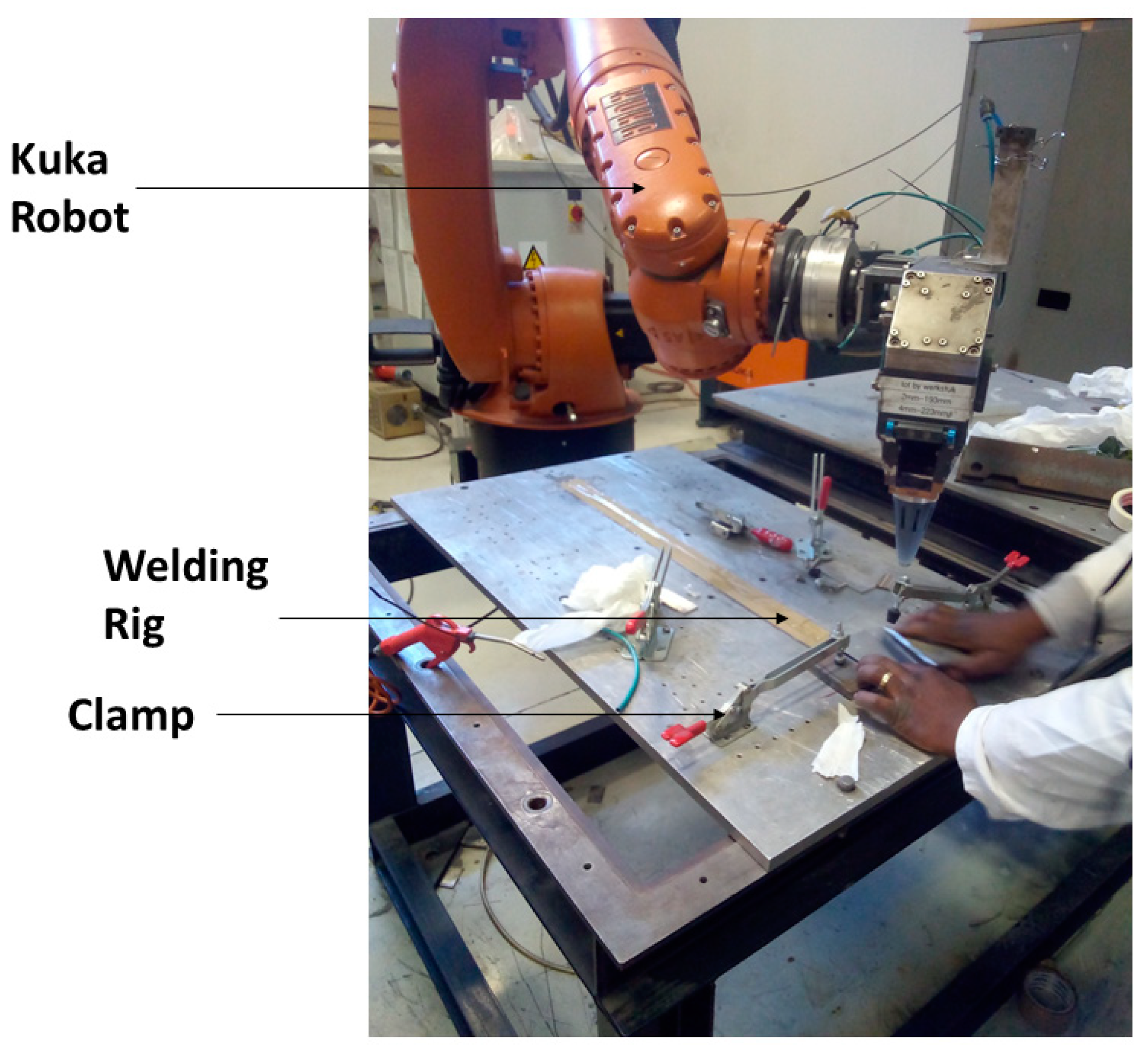
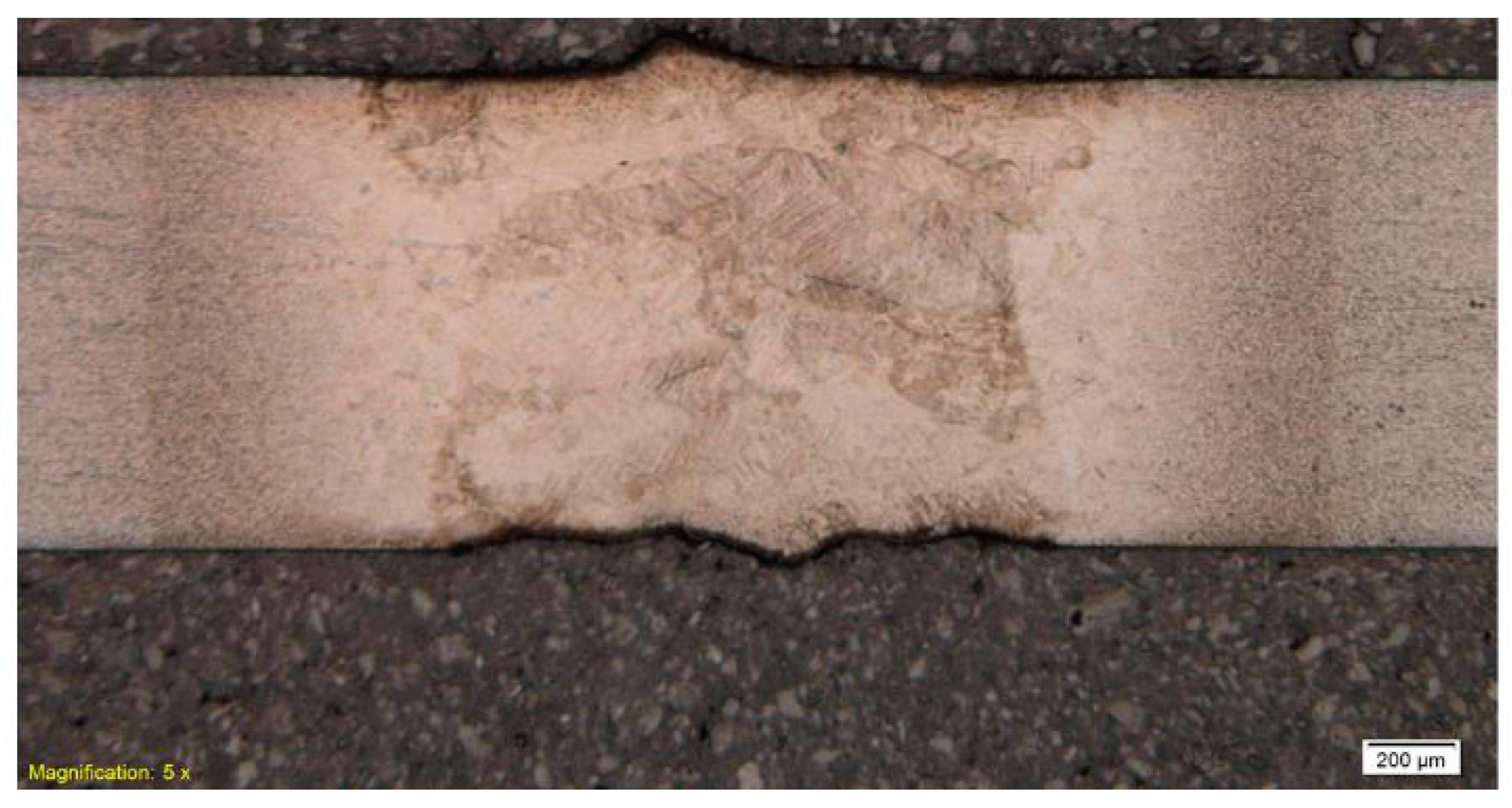
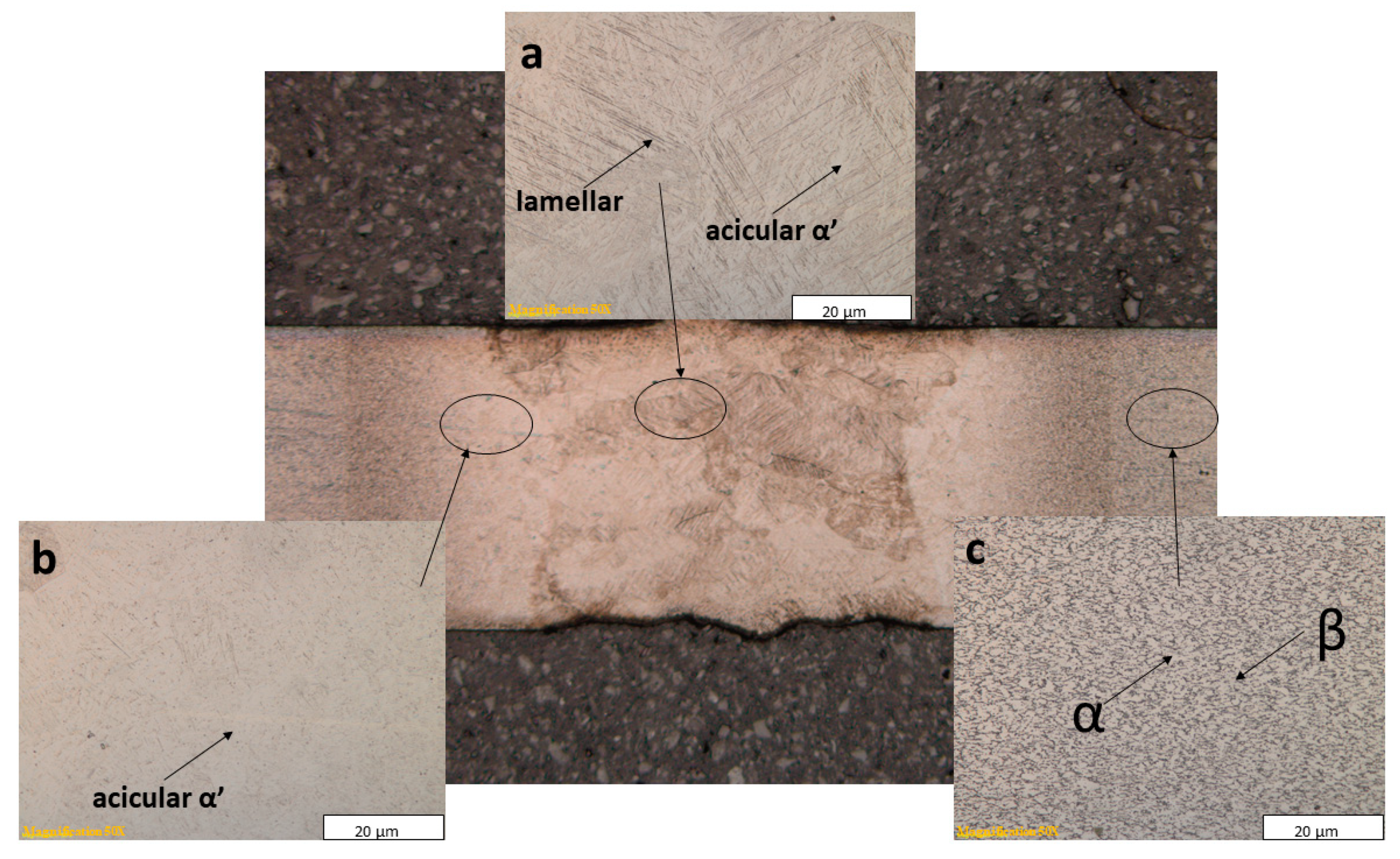
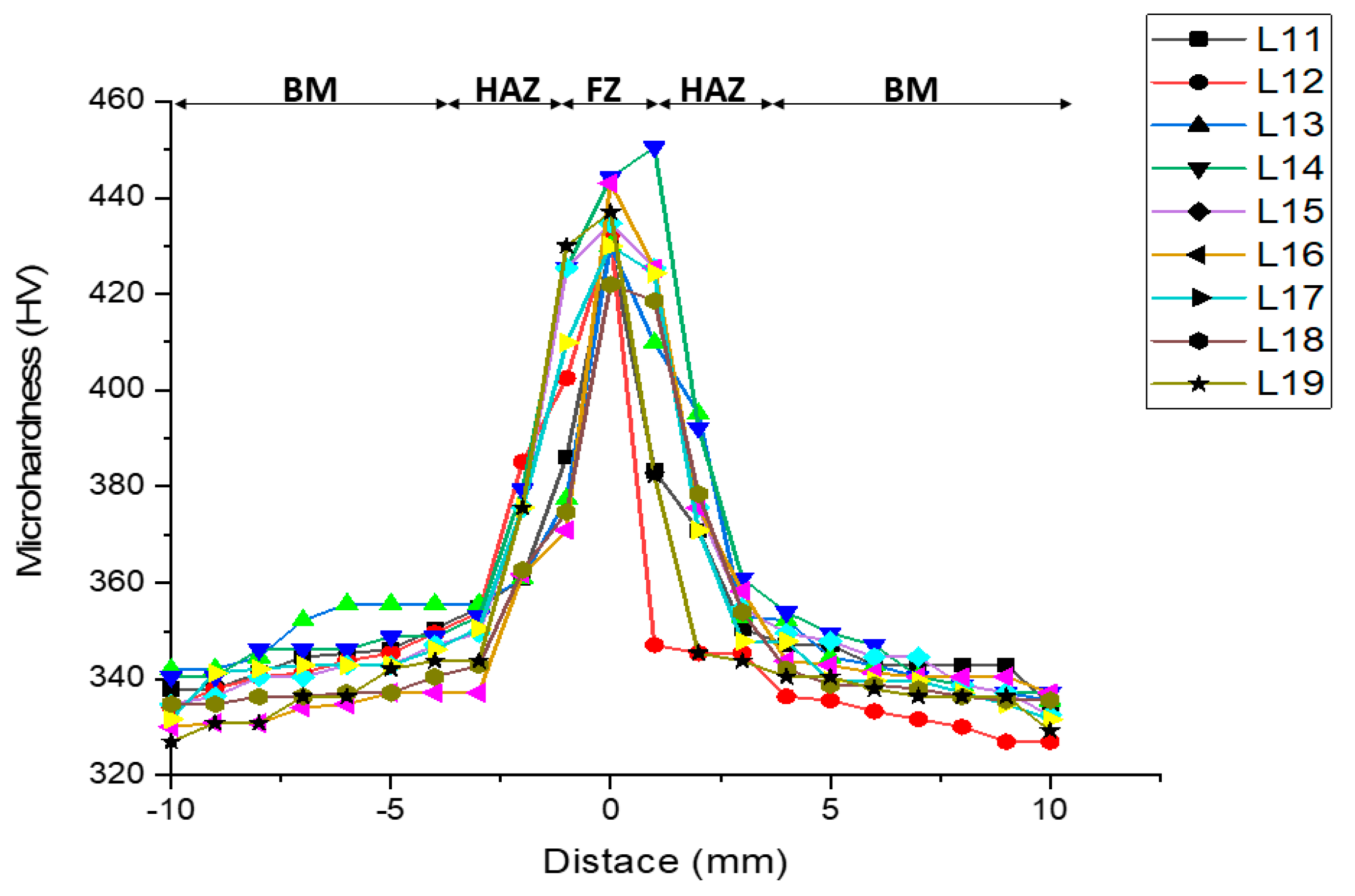
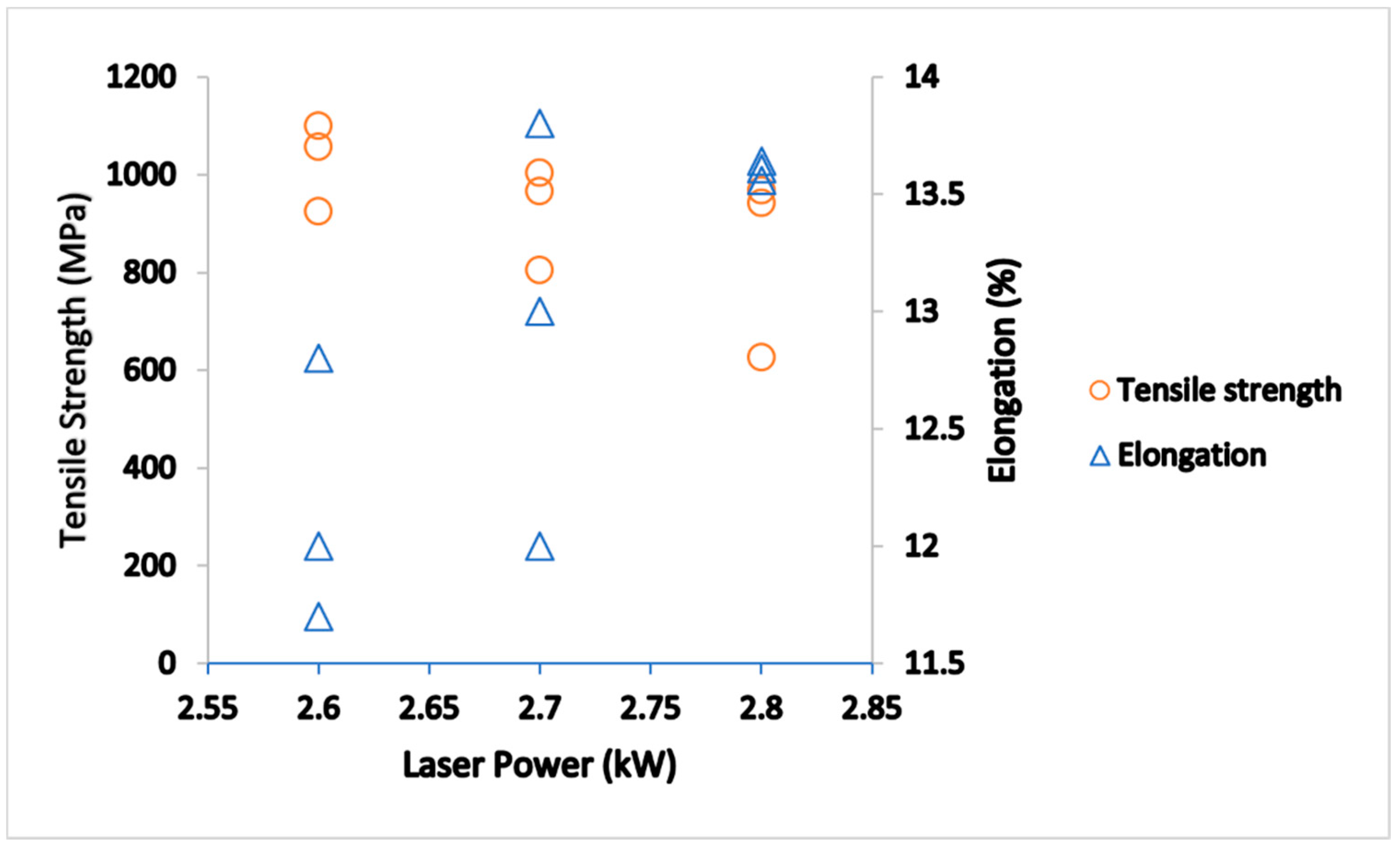
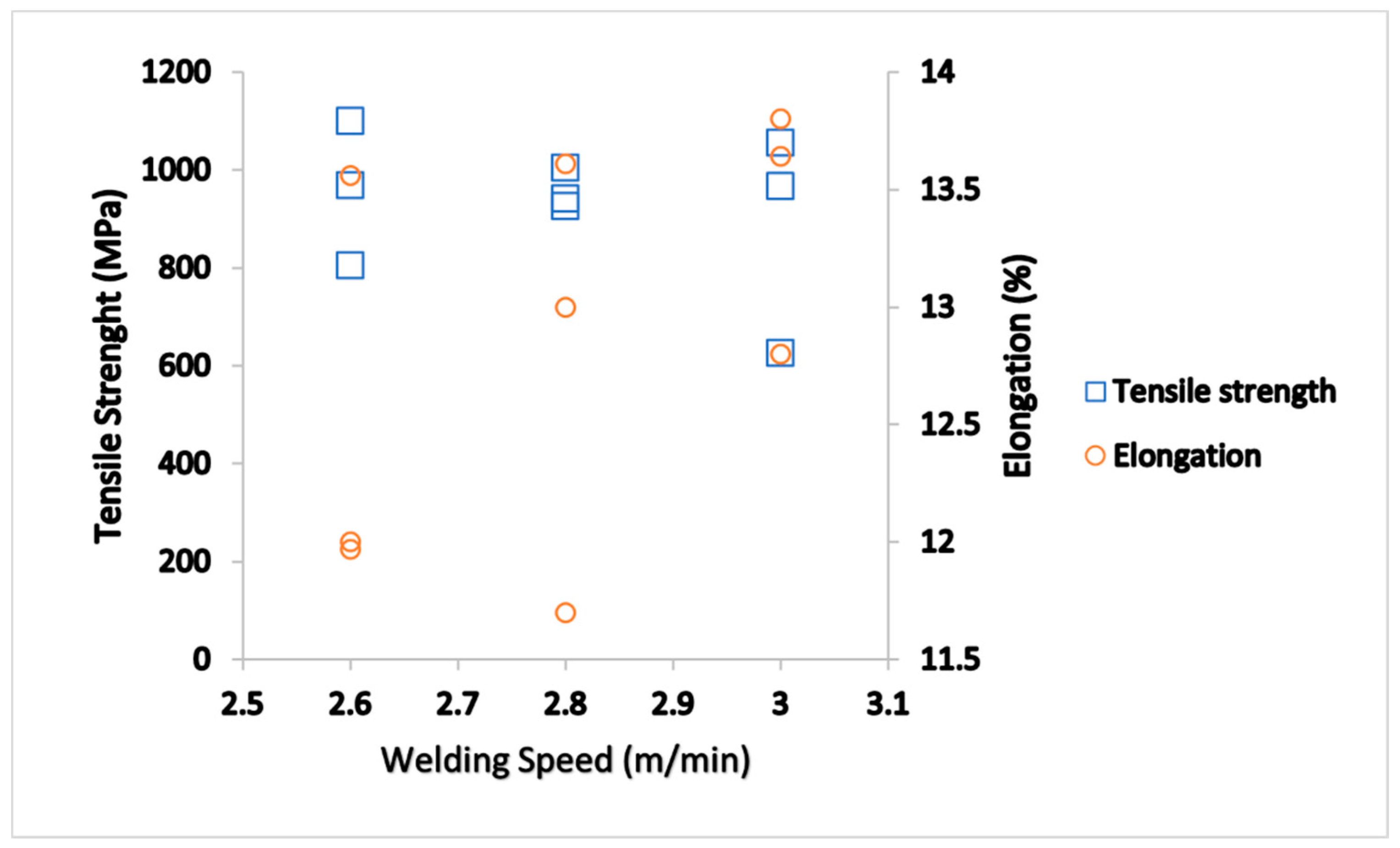
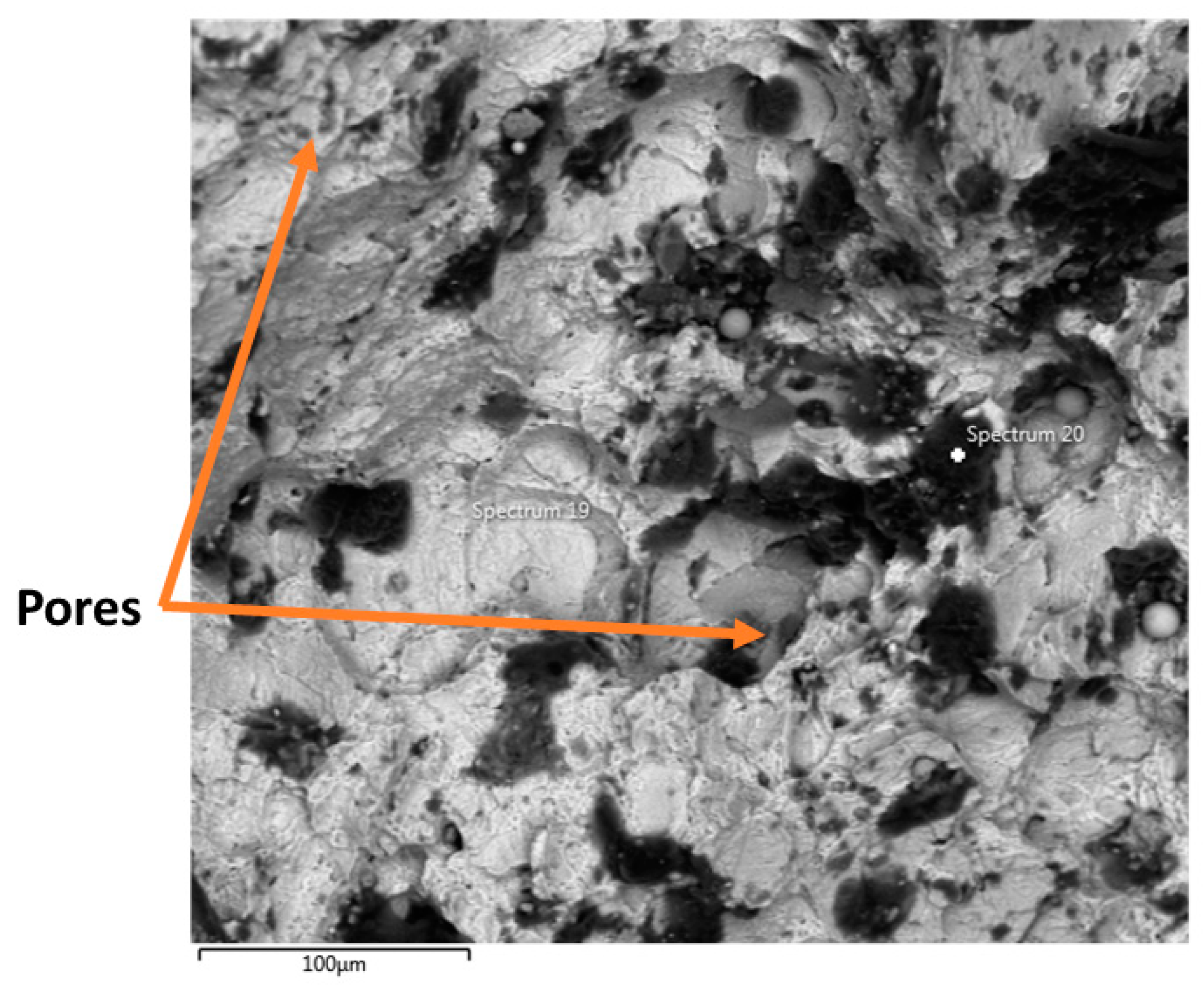
| Element | Ti | Al | V | Fe | C | N | H | O | Others |
|---|---|---|---|---|---|---|---|---|---|
| Weight (%) | Remainder | 6.10 | 4.0 | 0.15 | 0.03 | 0.018 | 0.002 | 0.13 | Each < 0.10 |
| Sample | Laser Power (kW) | Welding Speed (m/min) |
|---|---|---|
| L11 | 2.6 | 2.6 |
| L12 | 2.6 | 2.8 |
| L13 | 2.6 | 3.0 |
| L14 | 2.7 | 2.6 |
| L15 | 2.7 | 2.8 |
| L16 | 2.7 | 3.0 |
| L17 | 2.8 | 2.6 |
| L18 | 2.8 | 2.8 |
| L19 | 2.8 | 3.0 |
Publisher’s Note: MDPI stays neutral with regard to jurisdictional claims in published maps and institutional affiliations. |
© 2021 by the authors. Licensee MDPI, Basel, Switzerland. This article is an open access article distributed under the terms and conditions of the Creative Commons Attribution (CC BY) license (https://creativecommons.org/licenses/by/4.0/).
Share and Cite
Omoniyi, P.; Mahamood, R.; Arthur, N.; Pityana, S.; Skhosane, S.; Okamoto, Y.; Shinonaga, T.; Maina, M.; Jen, T.-C.; Akinlabi, E. Laser Butt Welding of Thin Ti6Al4V Sheets: Effects of Welding Parameters. J. Compos. Sci. 2021, 5, 246. https://doi.org/10.3390/jcs5090246
Omoniyi P, Mahamood R, Arthur N, Pityana S, Skhosane S, Okamoto Y, Shinonaga T, Maina M, Jen T-C, Akinlabi E. Laser Butt Welding of Thin Ti6Al4V Sheets: Effects of Welding Parameters. Journal of Composites Science. 2021; 5(9):246. https://doi.org/10.3390/jcs5090246
Chicago/Turabian StyleOmoniyi, Peter, Rasheedat Mahamood, Nana Arthur, Sisa Pityana, Samuel Skhosane, Yasuhiro Okamoto, Togo Shinonaga, Martin Maina, Tien-Chien Jen, and Esther Akinlabi. 2021. "Laser Butt Welding of Thin Ti6Al4V Sheets: Effects of Welding Parameters" Journal of Composites Science 5, no. 9: 246. https://doi.org/10.3390/jcs5090246
APA StyleOmoniyi, P., Mahamood, R., Arthur, N., Pityana, S., Skhosane, S., Okamoto, Y., Shinonaga, T., Maina, M., Jen, T.-C., & Akinlabi, E. (2021). Laser Butt Welding of Thin Ti6Al4V Sheets: Effects of Welding Parameters. Journal of Composites Science, 5(9), 246. https://doi.org/10.3390/jcs5090246









